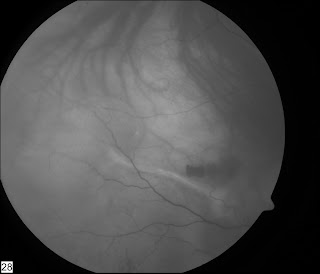Ant Seg - unremarkable, no cells in her vitreous.


Late ICG movie
Other eye had PDT some years ago for a fibrovascular PED and settled to a vision of 6/36, been stable for 5+ years.
Any idea about diagnosis? Management?
A training resource for vitreo-retinal surgeons of all grades, from beginner to vastly experienced


Late ICG movie
Other eye had PDT some years ago for a fibrovascular PED and settled to a vision of 6/36, been stable for 5+ years.
Any idea about diagnosis? Management?
Just got back from Antwerp, excellent meeting as usual in it's 10th edition.
Big play on air tamponade only for macular hole with 3 day face down posturing. I've done a few caes like this with mixed results, anyone else tried this?
The gauge wars continue - 25, 23 or 20? Different people propunding the virtues of one system over the other. What is the outside diameter of a 20g Trocar cannula system for transconjunctival surgery? Must be 19 gauge, if 20g instruments go through the cannula? Will have to look this one up.....
Som

Steps 1 to 5 are as above, then you can see the posterior hyaloid being detached and complete vitrectomy with vitreous base shave using indentation being done. After ILM peel a FAX (Fluid air exchange) is done which finishes with direct drainage from the hole - allowing the hole to close on the table- air is left in as tamponade.
Then 25g ports are removed - and in spite of agressive indentation and peripheral vitrectomy during the posterior segment procedure, the AC remains sealed, deep and well formed.
Following blunt trauma this girl presented with vitreous in the AC - formed vitreous - also a GRT (Giant Retinal Tear). At surgery, I thought that getting the vitreous out of the way in the AC - could be a good idea - so after instilling some Kenalog into AC to highlight Vit, I tried injecting into AC to push vit back into PC - did it work? - Watch the video and comment...